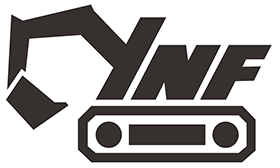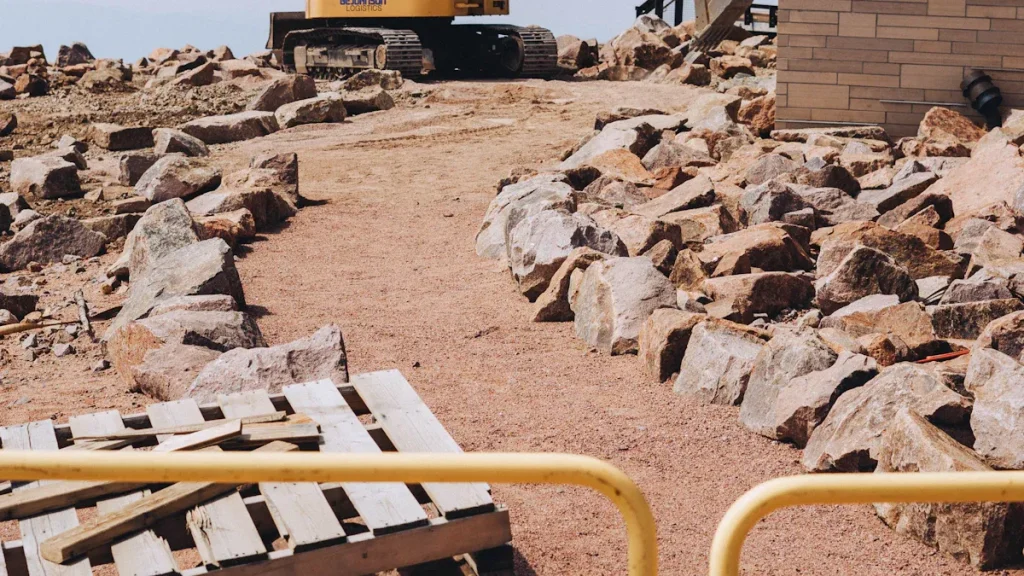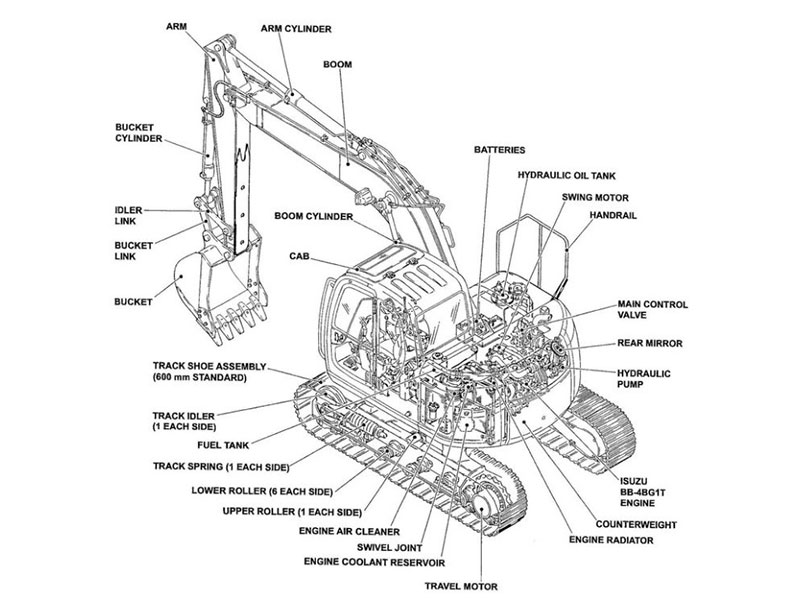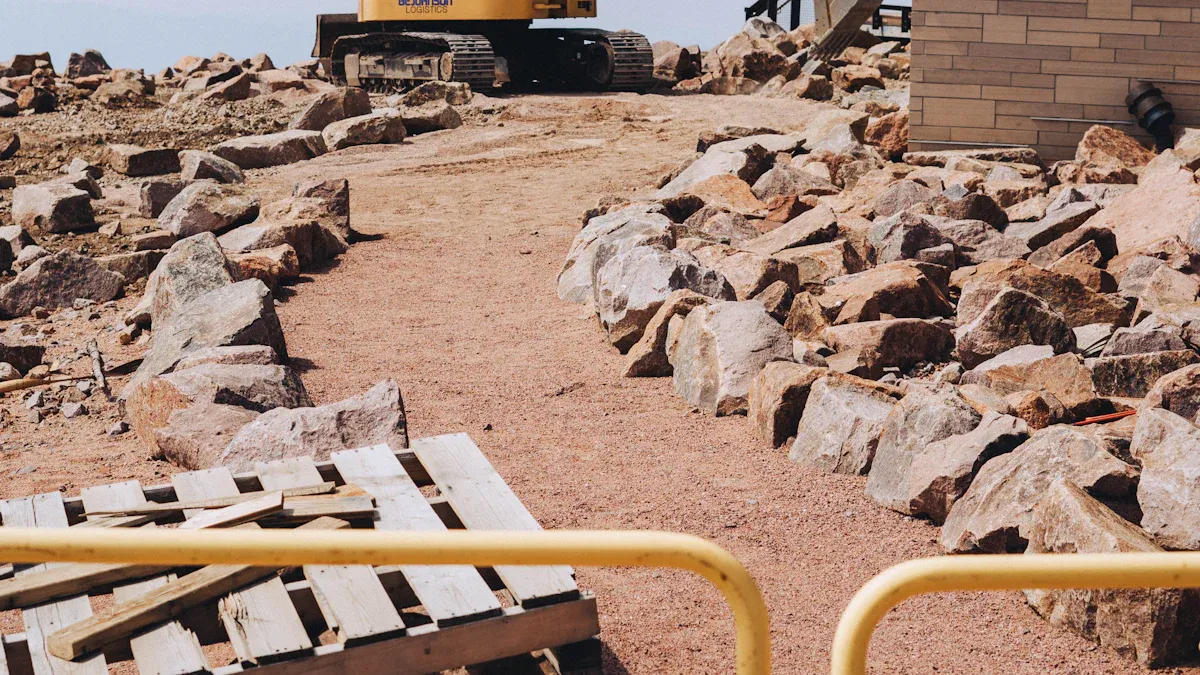
You will find the 1998 John Deere 80 excavator offers impressive specs for its size. See the main details below:
Specification | Value |
|---|---|
Operating Weight | 17,000 lbs |
Engine Power | 54 hp |
Overall Length | 21 ft 2 in |
Digging Depth | 14 ft 6 in |
Bucket Size | 0.34 yd³ |
The weight of this excavator lets you handle tough jobs. You get reliable performance and good digging depth. Many owners of john deere mini excavators look for this weight and size. If you need 1998 john deere 80 excavator parts, knowing the right weight and depth helps you choose the correct options. John deere mini excavators like this model make digging tasks easier.
Key Takeaways
The 1998 John Deere 80 excavator is strong and useful. It has good power and size. It works well in small spaces.
You should know important specs like weight, digging depth, and engine power. The weight is 17,000 lbs. The digging depth is 14 ft 6 in. The engine power is 54 hp. These help you pick the right attachments. They also help you plan your work safely.
Regular maintenance is important. You need to change filters often. You should check the tracks too. This keeps your excavator working well. It also helps it last longer.
You can pick steel or rubber tracks. Steel tracks are best for rough ground. Rubber tracks work better on soft surfaces.
Buy the right parts from trusted places. Use the fluids that are recommended. This protects your machine. It helps your excavator work well every time.
Overview of the Excavator
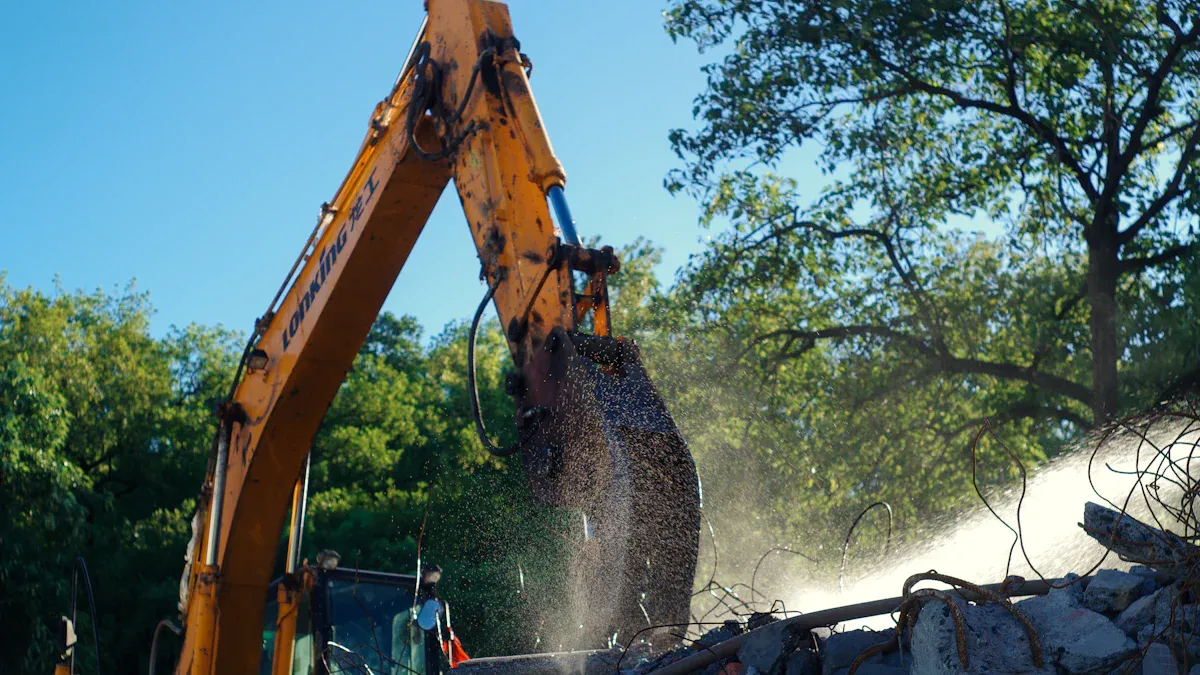
Main Features
The 1998 John Deere 80 is different from other john deere mini excavators. It has a good mix of power and size. You can use it for many jobs. It fits into small spaces easily. The cab lets you see clearly, so you can work safely. The controls are simple and smooth to use. The engine is reliable. It starts fast and does not make much noise.
If you check the excavator size guide, this model is a compact excavator. Its size makes it easy to move and transport. You can pick the best excavator by looking at the specs and your project needs. This machine can use many attachments. You can switch between digging, grading, and lifting. You can add buckets, hydraulic thumbs, and more to do different jobs.
Tip: Always make sure attachments fit your machine before buying. This helps you avoid problems and keeps your excavator working well.
Applications
The 1998 John Deere 80 excavator can do many jobs. It is good for landscaping, trenching, and utility work. Its size lets you dig where big machines cannot go. You can use it for homes or small business projects. Many people pick john deere mini excavators because they are flexible and dependable.
You can use different tools for each job. There are buckets for digging, grapples for moving things, and augers for making holes. You can change tools fast, which saves time and effort. This excavator helps you finish work faster and with less trouble.
If you want a machine that works for many projects, the 1998 John Deere 80 is a good pick. It is a strong excavator for many kinds of work. Its size and attachments make it useful for contractors and property owners.
Weight and Dimensions
Operating Weight
You need to know the weight of your 1998 John Deere 80 excavator before you start any job. The weight affects how you move the machine and what kind of trailer you need. This excavator has a weight of about 17,000 lbs. You can trust this weight for most tasks. The weight helps you dig deeper and lift heavier loads. When you check the weight, you make sure the ground can support the machine. The weight also tells you how stable the excavator will be when you reach full depth. If you want to use the full digging depth, you must know the weight. The weight gives you better control when you work at maximum depth. You should always check the weight before you transport the machine. The weight also affects how much you can carry in the bucket. If you use the wrong weight, you may damage the excavator. The weight is important for safety. You can avoid tipping by knowing the weight. The weight also helps you plan for the right job site. You can use the weight to compare this model with other machines. The weight is a key factor in every project.
Transport Dimensions
You need to measure the size of your excavator before you move it. The overall length is about 21 feet 2 inches. The width is close to 7 feet 7 inches. The height is about 8 feet 4 inches. These numbers help you plan for transport. You can use a trailer that fits the size of the machine. The size also helps you know if the excavator will fit through gates or narrow spaces. You should always check the size before you drive to a new site. The size makes it easy to move the excavator from one job to another. You can use the size to compare with other models.
Note: Always secure the excavator based on its weight and size to prevent accidents during transport.
Ground Clearance
Ground clearance is the space between the bottom of the excavator and the ground. You get about 1 foot 6 inches of ground clearance with the John Deere 80. This clearance lets you work on rough or uneven ground. You can avoid damage to the undercarriage if you know the ground clearance. The ground clearance also helps you reach the full digging depth without hitting rocks or debris. You should always check the ground clearance before you start digging. The ground clearance works with the weight to keep the machine stable. You can use the ground clearance to plan for deep trenches. The ground clearance also helps you avoid getting stuck. You can finish your job faster if you know the ground clearance and depth.
Engine
Engine Model
The 1998 John Deere 80 excavator has a strong engine. The engine model is Yanmar 4TNE84. This engine lasts a long time and works well. It starts fast, even when it is cold outside. The engine uses less fuel and makes less noise. Many people like this engine because it does not need much care. You can look under the hood to see the engine label. The Yanmar 4TNE84 gives steady power for digging and lifting.
Tip: Keep the engine clean and look for leaks often. This can help you stop big repairs before they start.
Horsepower
The engine gives you good power. The Yanmar 4TNE84 makes 54 horsepower (hp). This power helps you dig deep and lift heavy things. You can work in hard dirt without slowing down. Horsepower tells you how much work the engine can do. If you want to compare machines, check the horsepower. More horsepower means you can dig faster and work smoother. Enough power lets you finish jobs sooner. The John Deere 80 has a good mix of power and fuel use.
Engine Spec | Value |
|---|---|
Model | Yanmar 4TNE84 |
Horsepower | 54 hp |
Fuel Capacity
It is important to know your fuel tank size. The 1998 John Deere 80 holds 31 gallons of fuel. This big tank lets you work longer without stopping. You can finish big jobs in one day. The fuel tank is at the back of the machine. Always check the fuel before you start working. A full tank keeps you from running out. Using the right fuel helps the engine last longer and run better.
Fuel Tank Capacity: 31 gallons
Recommended Fuel: Diesel
Note: Always use clean diesel fuel. Dirty fuel can hurt the engine and make it work worse.
Knowing these engine specs helps you keep your excavator working well. The right engine, horsepower, and fuel size help you plan your work and stop problems.
Performance Specs
Digging Depth
You need to know the exact digging depth of your excavator before you start any project. The 1998 John Deere 80 gives you a maximum digging depth of 14 feet 6 inches. This depth lets you handle most jobs, from trenches to foundations. You can reach the full digging depth with ease. The machine keeps its stability even at maximum depth. You can trust the depth rating for both small and large projects. When you use the right attachments, you can improve your digging depth and get more out of your excavator. Always check the digging depth before you choose your next job.
Reach
The reach of your excavator tells you how far you can dig from the center of the machine. The John Deere 80 offers a reach of about 22 feet. This reach helps you cover more ground without moving the excavator. You can dig deep and far at the same time. The reach works with the digging depth to give you more options. You can use different attachments to extend your reach. This feature adds precision to your digging tasks. You can finish jobs faster when you know your reach and depth.
Bucket Capacity
The bucket capacity affects how much material you can move in one scoop. The standard bucket holds 0.34 cubic yards. You can use other attachments to change the bucket size. A larger bucket lets you move more dirt, but it may lower your digging depth. A smaller bucket gives you more precision and control. You should match the bucket to your job for the best results. The right bucket helps you reach the full digging depth and keeps your excavator working well.
Tear-Out Force
Tear-out force shows how much power your excavator has when breaking through tough soil. The John Deere 80 gives you strong tear-out force for hard digging. You can dig at full depth without losing power. This force helps you use the full digging depth with every scoop. You can add attachments to boost your tear-out force. The right setup gives you more precision and better digging depth. Always check the tear-out force before you start a tough job.
Tip: Use the right attachments for each job. This helps you get the best digging depth and precision from your excavator.
Hydraulic System
The hydraulic system in your 1998 John Deere 80 excavator gives you the power to dig, lift, and move with ease. You can rely on this system for smooth operation and strong performance. Understanding how the hydraulics work helps you get the most out of your machine.
Pump Type
Your excavator uses a variable displacement axial piston pump. This pump adjusts the flow of hydraulic fluid based on your needs. When you move the controls, the pump responds quickly. You get more power when you need it and save energy when you do not. This type of pump helps you work longer without overheating. It also makes the system more efficient. You can trust this pump for steady performance in tough conditions.
Tip: Check the pump for leaks or unusual noises. Early detection keeps your hydraulic system running smoothly.
Flow Rate
The flow rate tells you how much hydraulic fluid moves through the system each minute. The John Deere 80 delivers a maximum flow rate of about 32 gallons per minute (GPM). This high flow rate lets you use attachments that need a lot of power. You can dig, lift, and swing the arm with speed and precision. The flow rate also affects how fast you can finish your work. If you want to use advanced hydraulics, make sure your attachments match the system’s flow rate.
Hydraulic Spec | Value |
|---|---|
Max Flow Rate | 32 GPM |
System Pressure
System pressure measures the force inside the hydraulic lines. Your excavator operates at a maximum system pressure of 3,550 psi. High pressure gives you the strength to break through tough soil and lift heavy loads. You can count on this pressure for reliable digging and lifting. Always check the pressure gauge before starting a job. If the pressure drops, you may need to service the system.
Note: Keep the hydraulic fluid clean and at the right level. Dirty or low fluid can lower system pressure and damage parts.
Undercarriage
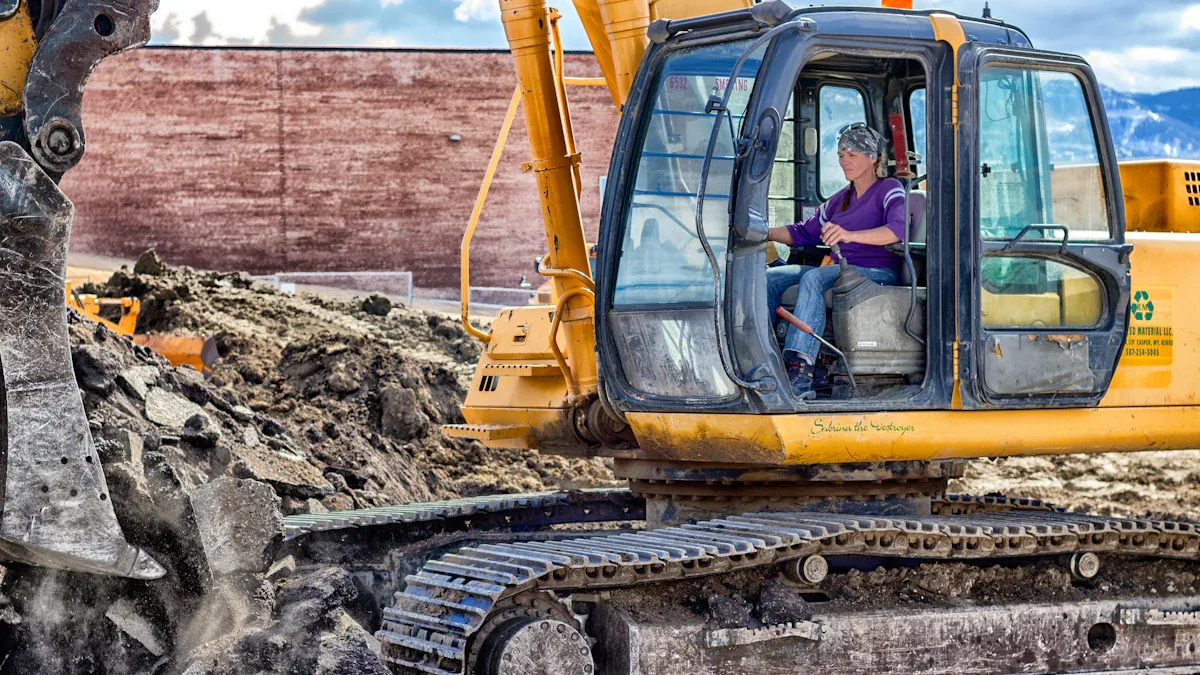
Track Width
Track width plays a big role in how your excavator handles different surfaces. The 1998 John Deere 80 uses tracks that measure about 17.7 inches wide. This width gives you a good balance between stability and maneuverability. Wide tracks help spread the weight of the machine. You get less ground pressure, so you can work on soft or muddy ground without sinking.
You should always check the track width before moving your excavator to a new job site. If you work in tight spaces, the standard width fits through most gates and narrow paths. Wider tracks can help if you need more stability on slopes or loose soil. Narrower tracks work better in confined areas but may not give as much support.
Tip: Clean the tracks after each use. Dirt and debris can build up and cause extra wear. Clean tracks last longer and help your machine run smoothly.
Track Type
The John Deere 80 comes with steel tracks as standard. Steel tracks give you strong grip and last a long time. You can use them on rough ground, gravel, or rocky areas. Steel tracks handle heavy-duty work and resist damage from sharp objects.
Some owners choose to switch to rubber tracks. Rubber tracks work well on finished surfaces like pavement or concrete. They cause less damage to the ground and make less noise. If you work in urban areas or on lawns, rubber tracks can help protect the surface.
Here’s a quick comparison:
Track Type | Best For | Pros | Cons |
|---|---|---|---|
Steel | Rough, rocky terrain | Durable, strong grip | Heavier, noisier |
Rubber | Pavement, soft ground | Quieter, less damage | Wears faster, costly |
You should pick the track type that matches your job needs. Always inspect your tracks for cracks or missing pads. Good tracks keep your excavator safe and efficient. If you notice uneven wear, adjust or replace the tracks right away. This helps you avoid bigger repairs later.
Key Features
Operator Comfort
You spend long hours in your excavator, so comfort matters. The 1998 John Deere 80 gives you a cab designed for easy use and less fatigue. The seat adjusts to fit your height and weight. You can move the armrests and seat position to find the best spot. The controls sit close to your hands, so you do not need to stretch or twist. This setup helps you work longer without feeling tired.
The cab has large windows. You get a clear view of your work area. Good visibility helps you avoid mistakes and work faster. The cab also keeps out dust and rain. You stay dry and clean, even on tough jobs. The heater keeps you warm in cold weather. You can open the windows for fresh air when it gets hot.
Here are some comfort features you will notice:
Adjustable suspension seat for less back strain
Easy-to-reach joystick controls
Wide entry door for quick access
Good sound insulation to lower noise
Cup holder and storage space for your gear
Tip: Take short breaks during long jobs. Stretch your arms and legs to stay comfortable all day.
Safety
Safety should always come first when you operate heavy equipment. The John Deere 80 includes features that help protect you and others on the job site. The cab has a strong frame that shields you from falling objects. The seat belt keeps you secure if the machine moves suddenly.
You will find safety locks on the control levers. These locks stop the machine from moving by accident. The large mirrors and clear windows help you see people and obstacles around you. The bright work lights let you work safely in low light.
Here is a quick safety checklist:
Always wear your seat belt
Check the mirrors before moving
Use the control lock when not operating
Inspect the lights and alarms before each shift
Note: Review the operator’s manual for more safety tips. Safe habits protect you and your team every day.
1998 John Deere 80 Excavator Parts
Common Parts
To keep your excavator working well, you need the right parts. The 1998 john deere 80 excavator parts you use most are filters, tracks, hydraulic parts, and buckets. Each part helps your machine do its job.
Engine Oil Filter: This filter stops dirt from getting in the engine. Change it every time you change the oil.
Fuel Filter: Clean fuel helps the engine run better. Change this filter to stop clogs and engine problems.
Hydraulic Filters: These filters keep the hydraulic system safe. Change them often for smooth movement.
Tracks (Steel or Rubber): Tracks help your machine grip the ground. Look for cracks or damage. Replace them if they are worn out.
Bucket Teeth: Sharp teeth make digging easier. If the teeth are dull, digging gets harder.
Pins and Bushings: These connect the arms and buckets. If you hear squeaks or see loose parts, check these.
Hydraulic Hoses and Seals: Hoses move fluid to the arms and bucket. Leaks can make a mess and lower power.
Cooling System Parts: Radiators and oil coolers stop the engine from getting too hot. Clean or replace them when needed.
Electrical Components: Fuses, lights, and switches help you work safely, even when it is dark.
You might also need other 1998 john deere 80 excavator parts like swing motors, final drives, and control valves. Keep some spare parts ready so you do not have to wait.
Tip: Look in your operator’s manual for the right part numbers. This makes it easy to order the correct parts.
OEM vs Aftermarket
When you buy 1998 john deere 80 excavator parts, you can pick OEM or aftermarket. Each type has good points.
OEM Parts
OEM parts come from John Deere or their partners. These parts fit your machine just right. They work well and last a long time. OEM parts usually cost more, but they help keep your warranty safe.
Aftermarket Parts
Aftermarket parts come from other companies. They may cost less and sometimes have new features. Some aftermarket parts work as well as OEM, but quality is not always the same. Always read reviews and ask about warranties before buying.
Here are some good places to get both OEM and aftermarket parts:
YNF Machinery has many John Deere excavator parts. They sell used, rebuilt, and remanufactured parts. They test parts for quality and ship fast, often the same day. You can call them or use their website.
Note: Always check prices, shipping, and warranties. Ask if the parts are tested before you buy.
Maintenance
Doing regular maintenance helps your excavator last longer and saves money. Follow a schedule for checking and changing 1998 john deere 80 excavator parts.
Daily: Check tracks, look at fluid levels, and watch for leaks. Clean the cab and windows so you can see better.
Every 250 Hours: Change the engine oil and oil filter. Use John Deere Plus-50 II 15W-40 engine oil for best results. This oil works well in older engines and helps them last.
Every 500 Hours: Change hydraulic filters and check hoses for leaks or cracks. Use hydraulic fluids that match John Deere’s OEM specs. These fluids protect seals and keep things running smooth.
Every 1,000 Hours: Check and change pins, bushings, and bucket teeth. Look at the cooling system and clean or replace the radiator and oil cooler.
As Needed: Change old electrical parts, lights, and switches. Check all attachments for wear and make sure they fit right.
Tip: Always use fluids and lubricants that John Deere recommends. This keeps your excavator running well and protects your warranty.
Keep a log of all maintenance. Write down every part you change and each service you do. This helps you see patterns and plan repairs. When you use the right 1998 john deere 80 excavator parts and take care of your machine, it will work well for many years.
FAQ
What is the recommended engine oil for the 1998 John Deere 80 excavator?
You should use John Deere Plus-50 II 15W-40 engine oil. This oil protects your engine and helps it last longer. Always check your operator’s manual for the latest oil recommendations.
How often should you change the hydraulic filters?
You should change the hydraulic filters every 500 hours of use. Clean filters keep your hydraulic system running smoothly. Always check for leaks or damage during each service.
Can you use rubber tracks instead of steel tracks?
Yes, you can use rubber tracks. Rubber tracks work well on pavement and lawns. They cause less ground damage and make less noise. Always check that the tracks fit your machine before installing them.
What is the maximum digging depth of the John Deere 80?
The maximum digging depth is 14 feet 6 inches. This depth lets you handle most trenching and foundation jobs. Always check the ground conditions before digging to ensure safety.
Where can you buy replacement parts for your John Deere 80 excavator?
You can buy parts from John Deere dealers, BRIKERS, or Broken Tractor. These sources offer new, used, and rebuilt parts. Always compare prices and check for warranties before you buy.
